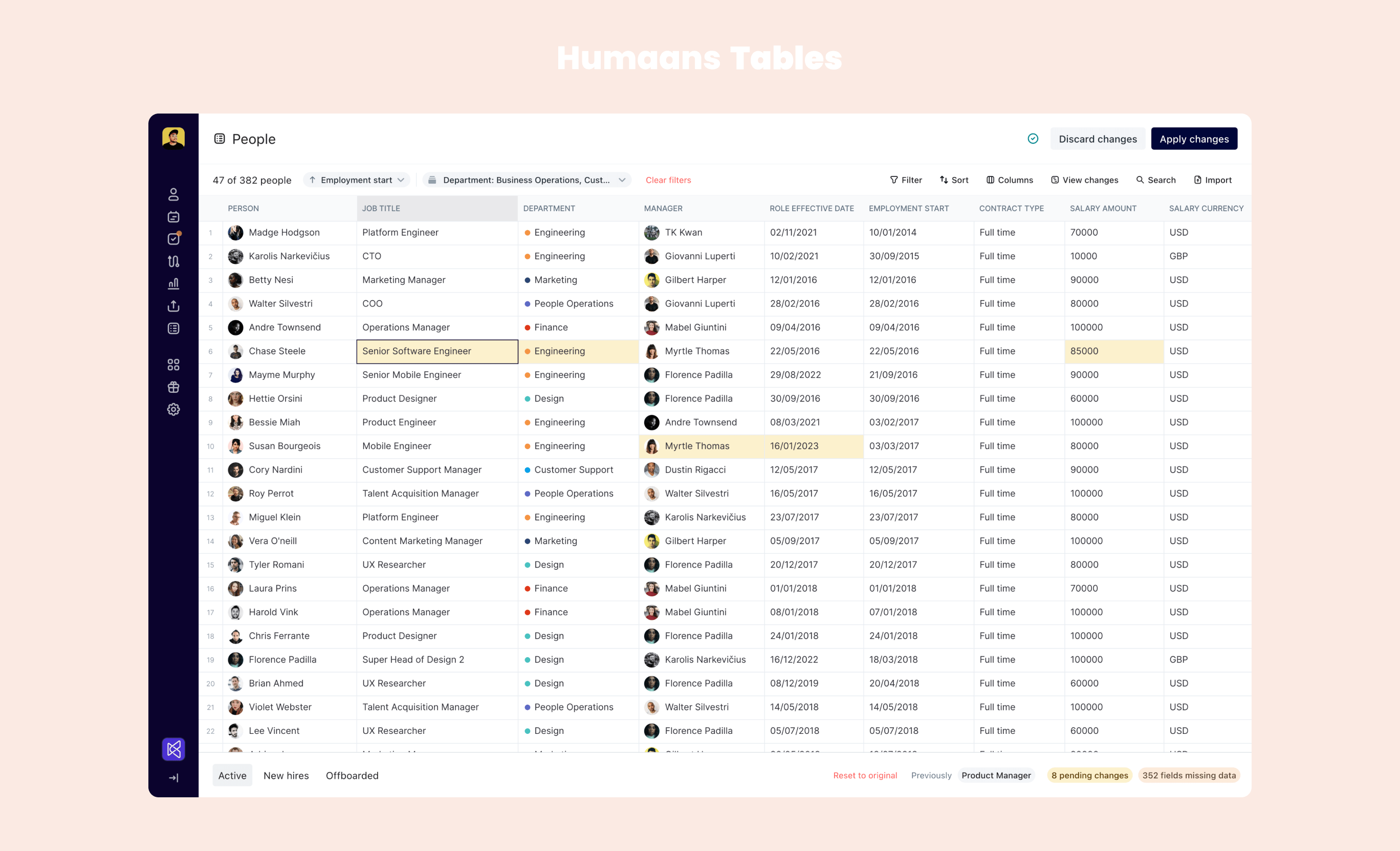If I could use one word to describe the current tech landscape, it would be contradictory. Some companies are reducing their costs by shedding staff. In the meantime, others are scaling up, expanding their reach, and creating new roles.
One thing remains constant, whether reducing roles or onboarding new employees, you need good HR practices. And while scrappy may be the modus operandi when you're small and agile, growing your business comes with new challenges. HR tech startup, Humaans is here to help with their latest product, Tables.
A few years ago Giovanni Luperti and Karolis Narkevicius found that unlike design tools used in their product design backgrounds, HR software was "clunky and slow" even for seemingly straightforward processes like managing direct reports and booking time off.
With some initial proof of concept, the founders participated in the Y Combinator accelerator program, and following graduation, Humaans (that's not a typo) was born. I spoke to Luperti to find out more.
A new way to do HR
The UK company develops a software solution that helps HR teams onboard, manage and grow their employees through fast workflows, automation and quick access to data. It turns previously disparate data into simple workflows by integrating with other point solutions, such as Gsuite, Slack, DocuSign, and Greenhouse.
And investor interest demonstrates it solves very real company pain points. Humaans raised an initial $5 million in seed funding. This was followed by a further $15 million in 2022.
Its investors include product-led founders like Slack founder Stewart Butterfield; Shopify founder Tobias Lütke; Figma Founder Dylan Field; Linkedin Founder Jeff Weiner, and Stripe COO Claire Johnson. Its clients include Pleo, Fidel API, and Fonoa.
The challenge of employee growth
According to Luperti, growing companies experience a transitional phase where they realise their HR practices can't serve their purposes anymore.
Imagine the onboarding required when a company transitions from 100 employees to 200 or even 500. Humaans helps these businesses improve their hiring framework, applicant tracking, and onboarding process.
And this is especially important as companies scale globally, as Europe's fragmented compliance regulations can differ per country and vary in complexity.
Luperti explains, "If you're hiring people across the UK, Brazil, and simultaneously you might need a different applicant tracking systems to collect different data points as part of the hiring journey for each location."
Europe's fragmented compliance requirements make international expansion especially onerous:
"Take how you report time off in certain regions. In the UK, the system is pretty straightforward. But in France, it's completely different."
Companies can also use Humaans to track changes in headcount over time in each department, sick days and working-from-home trends, and gender pay disparities.
It can also help with staff retention by tracking remuneration and performance reviews to ensure that staff in essential roles feel validated and rewarded.
Wrestling with large data sets is painful.
More data, poorly managed, means inaccuracies and data silos which fail to lead to critical insights. HR, People, Talent, and Finance teams spend a lot of time using spreadsheets when dealing with people data.
Spreadsheets are often out of sync with real data, disconnected from workflows and processes, resulting in many hours of manual entry, and are at higher risk of exposing confidential data offline.
According to Luperti, "This data is usually stored in different spreadsheets, which may not be up to date and disconnected from workflows and processes. This results in many hours of manual entry."
And worse, the data may be shared via Slack or email, without a plan to control who gets access to specific data portions. Employee data is highly sensitive and needs to be carefully access controlled.

In response, Humaans is launching a new product, Tables. It allows browsing, filtering, reporting, manipulating, and importing all of your employee data.
The product facilitates the management of large people-data sets at scale with the ability to visualise and share data subsets such as job titles, compensation, onboarding, role planning, and headcount. Users can also make edits and changes in bulk.
The great downsizing
While people often think of HR in terms of people at the beginning of their journey with a company, it's equally important when a company focuses on talent consolidation or, well, letting people go.
According to Luperti, a granular view of personnel helps bosses understand the costs of staffing:
"The most expensive cost for many startups and scaleups is their staff. Tables enables you to get an overview of an employee's tenure, the time since their last raise, the time since last promotion, and while keeping the view centralised and secure."
Therefore if you need to cut costs, you can make business-driven decisions. This could mean reviewing performance management and engagement to ensure you retain essential talent. Or, in the case of layoffs, "how do you make sure that you have a compensation package reflective of an employee's level of performance?"
So whether your company is increasing its headcount or reducing costs, a comprehensive employee management platform makes it possible to make decisions backed by data.
And with many companies faced with the challenges associated with expansion or reduction, making decisions you can stand by has never been more important.
Lead image: Tim Gouw.



Would you like to write the first comment?
Login to post comments